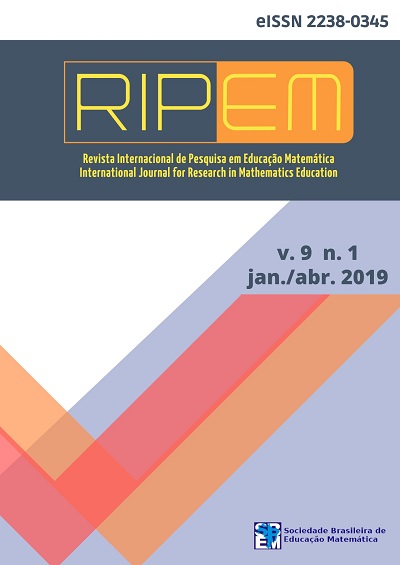Using touchscreen devices to improve plane transformation in high school classroom
Palavras-chave:
Mobile Device, Learning, Isometry, GeoGebra App, Geometric ConstructerResumo
Finding ways to improve geometry learning with dynamic geometric environment with touchscreen (DGEwT) is a new challenge in mathematics education. In this paper we illustrate some strategies concerning plane transformation used by two students to solve tasks on GeoGebra App and on Geometric Constructer (GC). Data came from videotapes of students working on the software, written answers for each task, the use of one shift in which he or she could write down and describe the function of each device icon, and from recorder SCR PRO. Two analytical protocols are presented. The proposed task and the possibilities of interaction provided by each device were fruitful to make emerge concepts related with plane transformation and to help students to solve the task by making spontaneous composition between them in a non-linear reasoning. Symmetry based on mirroring ideas took place in students’ strategy as a scaffolding concept during their interaction.
Downloads
Referências
Arzarello, F., Bairral, M., & Dané, C. (2014). Moving from dragging to touchscreen:
geometrical learning with geometric dynamic software. Teaching Mathematics
and its Applications 33(1): 39-51.
Assis, A. R. de (2016). High school students working in GeoGebra and in Geometric
Constructer: Hands and rotations in touchscreen. Master Thesis in Education.
Federal Rural University of Rio de Janeiro: Institute of Education.
Bairral, M. A. (2017). As Manipulações em Tela Compondo a Dimensão Corporificada
da Cognição Matemática. JIEEM, 10(2), 104-111.
Bairral, M., Arzarello, F., & Assis, A. (2017). Domains of manipulation in touchscreen
devices and some didactic, cognitive and epistemological implications for
improving geometric thinking. In G. Aldon, F. Hitt, L. Bazzini, & U. Gellert
(Eds.), Mathematics and technology: a CIEAEM source book (pp. 113-142):
Springer.
Bairral, M., & Assis, A. (2017). Touchscreen devices and task design to improve plane
transformation in high school classroom. Quaderni di Ricerca in Didattica:
Matematica 27 (Supplemento n. 2), 135-139.
Bairral, M. A., Arzarello, F., & Assis, A. (2015). High School students rotating shapes
in GeoGebra with touchscreen.Quaderni di Ricerca in Didattica: Matematica 25
(suplemento 2), 103-108.
Bairral, M., Assis, A. R., & Silva, B. C. da. (2015). Mãos em ação em dispositivos
touchscreen naeducação matemática. Seropédica: Edur.
Boncoddo, R., Williams, C., Pier, E., Walkington, C., Alibali, M., Nathan, M., Dogan,
M.F. &Waala, J. (2013). Gesture as a Window to Justification and Proof.
Proceedings of the 35th annual meeting of the North American Chapter of the
International Group for the Psychology of Mathematics Education. M. C. S.
Martinez, A. Chicago, IL, University of Illinois at Chicago: 229-236.
Damásio, A. R. (2010). O livro da consciência: A construção do cérebroconsciente.
Porto: Temas e Debates.
Kruger, R., Carpendale, S., Scott, S.D., Tang, A. (2005). Fluid Integration of Rotation
and Translation. Paper presented at the Proceedings of the ACM Conference on
Human Factors in Computing Systems (CHI)'05, April 2-7, 2005, Portland,
Oregon, USA, pp. 601-610.
McNeill, D. (2002). Gesture and Language Dialectic. Acta Linguistica Hafniesia, 1-25.
Radford, L. (2014). Towards an embodied, cultural, and material conception of
mathematics cognition. ZDM – The international journal on Mathematics
Education, 46(3), 349-361.
Tang, A., Pahud, M., Carpendale, S., & Buxton, B. (2010). VisTACO: Visualizing
Tabletop Collaboration. Paper presented at International Conference on
Interactive Tabletops and Surfaces (ITS '10), Saarbrücken, Germany.
Publicado
Como Citar
Edição
Seção

Este trabalho está licensiado sob uma licença Creative Commons Attribution-NonCommercial-ShareAlike 4.0 International License.








